Having a green water algae bloom in your freshwater aquarium can be a frustrating experience.
Green water blooms make it hard to see your fish and plants. This type of algae bloom seems to appear out of nowhere and is sometimes very difficult to control.
The good news is there are steps you can take to control green water algae blooms and clear the water. But first, let’s take a look at what causes the water to turn green and look like pea soup.
[toc]
Regular Algae vs. Green Water
You’re probably familiar with algae that grow on aquarium glass, gravel, and ornaments. These algae attach to a solid surface and form a green or brown coating.
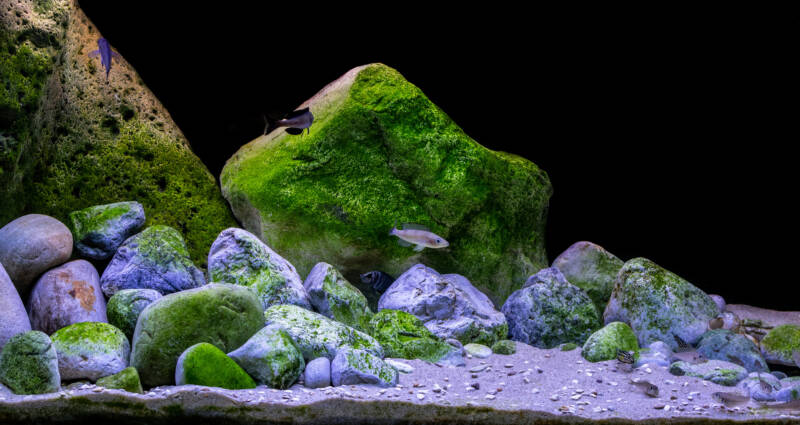
But nothing can prepare you for green water. It starts out as a slight discoloration in the water. The water may even have a slight greenish tint.
But over time, the water can become so green that you can’t see the fish unless they come up to the glass. This condition is caused by free-floating green algae.
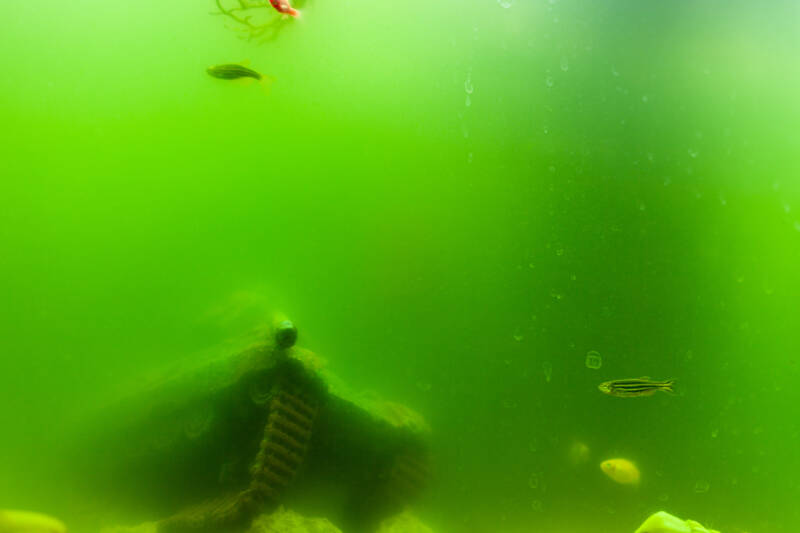
There are many species of green algae that cause green water. Chlorella is one of the most common. The tiny algae cells divide repeatedly, creating more and more green cells, which eventually cause the water to become green.
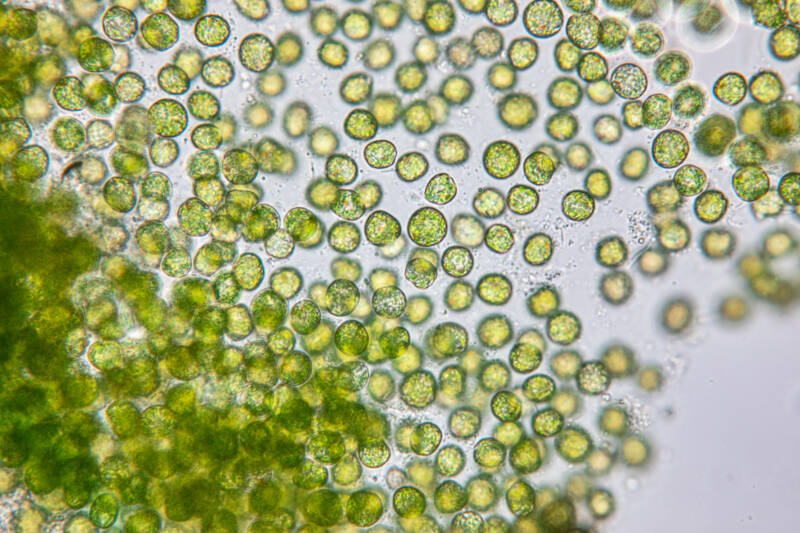
Are green water blooms harmful?
Generally, a green water bloom is harmless. It just makes the aquarium look bad.
But there are situations where it can hurt your fish. If the algae bloom suddenly dies due to lack of nutrients, the decaying algae can rob the water of oxygen.
This causes the fish to gasp at the surface of the aquarium. If extra aeration is not added, the fish may die.
Another type of bloom, caused by harmful strains of blue-green algae, has been proven to be toxic to aquatic life and even animals that drink the water.
It is impossible to identify harmful blue-green algae without a microscope. We will talk more about blue-green algae when we discuss control measures.
Where do green water algae come from?
Green algae live almost anywhere there is light, nutrients, and a wet environment.
Lakes, ponds, puddles, and even damp soil are all usual places where green algae live. Algae cells are even carried through the air in water vapor.
So, it is no surprise that green algae appear in our aquariums. Algae often hitchhike on the surface of the tropical fish you add to your tank.
What do green water algae need to grow?
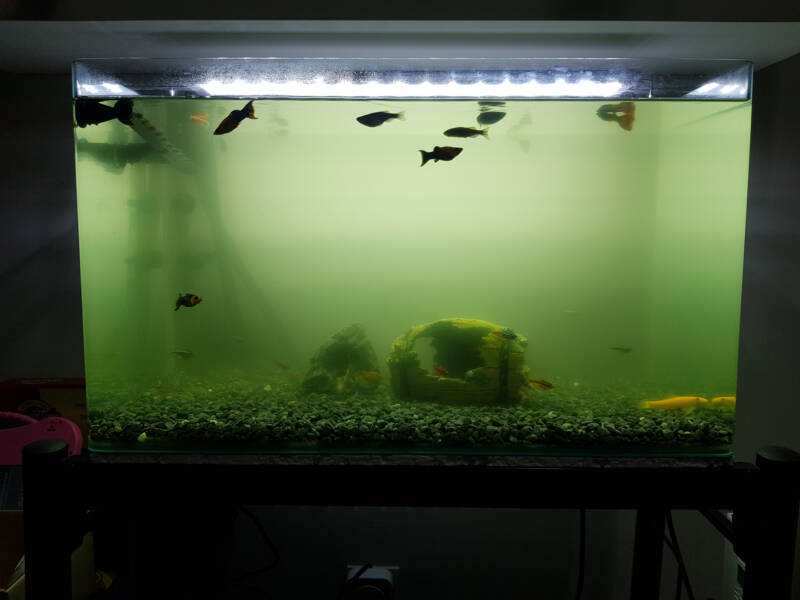
Keep in mind that green algae are just like other plants. They need:
- Light for photosynthesis
- Nutrients
- Carbon dioxide.
Your aquarium has all of these and more! The aquarium light provides light energy for photosynthesis.
Fish food and fish waste add nutrients like phosphate and nitrate to the water. Carbon dioxide is released by the fish and also diffuses into the water from the air.
The aquarium filter circulates the water, keeping the algae cells moving through the nutrient-rich water. As you can see, the aquarium is the perfect environment for algae to thrive.
Why don’t all aquariums have algae problems?
Even though aquariums are a great environment for algae, algae are normally kept under control for several reasons.
Even though the water looks clear, it contains millions of algae cells. There just aren’t enough cells to tint the water green.
It is only when the number of green algae cells becomes so high that the water looks green. So why don’t all aquariums turn green?
If only one essential nutrient, like iron, is lacking, the algae population cannot bloom. Natural nutrient competition between different algae species keeps the population in balance.
Aquatic plants release chemicals that inhibit algae growth. Under these conditions, algae are kept in check, and the water stays clear.
What to Do If You Have a Green Water Bloom
A green water bloom ranges from a mild tint to thick pea soup.
The thick green water is the hardest to control and poses the most risk to the aquarium. If all those algae suddenly die, it can cause oxygen depletion.
Take a look at these time-proven suggestions and choose which ones best suit your situation.
Why water changes may not work
Water changes are often recommended whenever something is not right in the tank. In the case of green water, multiple water changes over several days can dilute nutrients and help to starve algae.
But in some cases, your tap water may contain higher nutrient levels than your aquarium. The aquarium water may clear up for a day or so, then the water turns green again.
It won’t hurt to try water changes and see if it works. You may benefit from a reverse osmosis filter system.
Reverse osmosis water will not add nutrients to the tank. RO water changes and top-offs will help minimize excess nutrients in the aquarium water.
Aquariums that use RO water tend to have fewer algae problems.
What about a larger filter?
A larger filter probably won’t help. Most aquarium filter cartridges cannot remove the tiny single-celled algae. They pass right through the filter.
The algae that live in the water are constantly reproducing. Even if the filter could remove some algae, the green algae will just keep growing in the tank.
Can I use an algaecide?
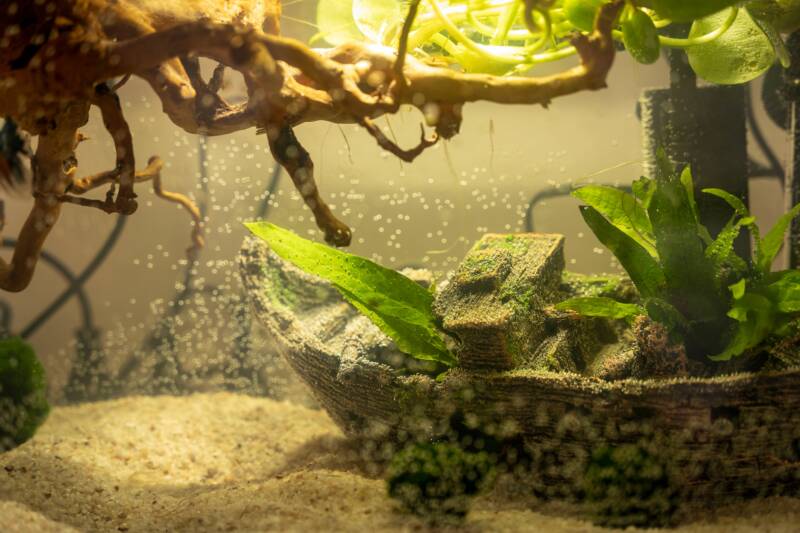
Algaecides can reduce the algae population. If the algae are causing a slight discoloration, a full dose of algaecide is recommended.
If the water is strongly tinted, a rapid die-off of algae can cause oxygen depletion in 24 hours or less.
In the rare chance you have harmful blue-green algae, a rapid die-off can harm the fish.
- Use an air stone to ensure there is plenty of oxygen.
- Use a ½ dose of algaecide every few days until the water clears.
- Be prepared to make a water change if there is a sudden die-off of algae, or the fish look stressed.
Turn off the light
Many aquarists have had success by turning off the aquarium light for several days. If there is natural light in the room, wrap the aquarium in black plastic to reduce the light entering the tank.
This chemical-free method often forces the algae to die back, allowing a natural algae balance to form.
UV sterilizers
sterilizers kill algae cells as they pass by the ultraviolet light. sterilizers are a proven way to stop algae from turning your aquarium green.
You will find sterilizers in many sizes and configurations:
- In-line to work with canister filters,
- Built-into canister and hang-on power filters,
- Stand-alone sterilizers for small aquariums.
Tips for preventing green water
As we’ve discussed, the aquarium is a perfect environment for algae. Fortunately, a healthy aquarium with good water quality rarely has a long-term algae problem.
Over-crowding and over-feeding create excess nutrients that support thick algae growth. Use a timer to keep the light on only for about 12 hours or less.
Final Thoughts
Occasional algae growth is part of having an aquarium. A green water bloom can happen to anyone, but you can minimize the chances by following the steps outlined in this article.
If you have any questions or comments, please leave them below.
